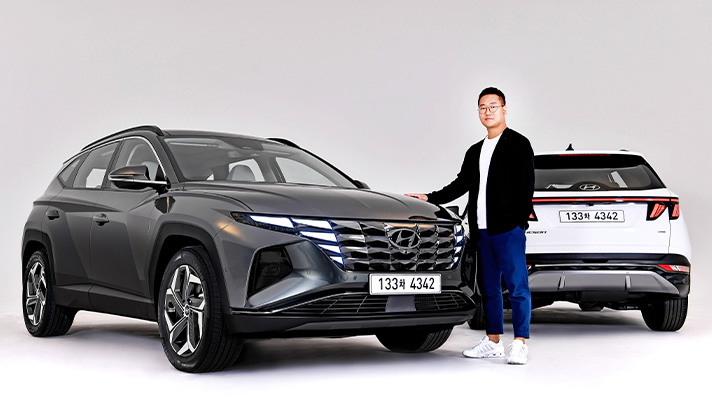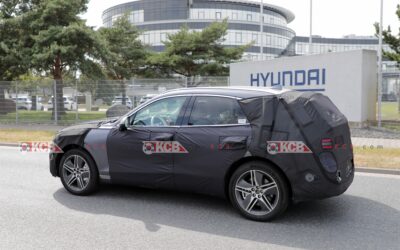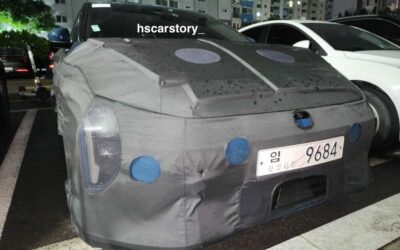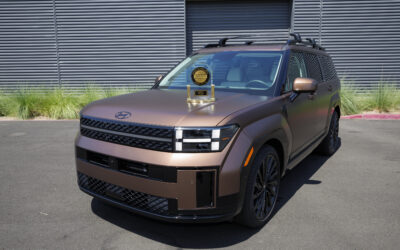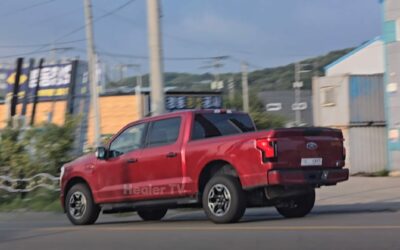The Tucson, Hyundai Motor Company’s biggest-selling vehicle worldwide, first appeared in 2004 and sold over 7 million units in cumulative sales worldwide until June this year. This is why Tucson is called the signature SUV that sells itself globally. And that’s why the world is paying attention to the fourth-generation Tucson, which is about to be released.
[ads id=”9″]
There is another reason why the new Tucson is gaining attention. This is because of the futuristic design that seems like a concept vehicle. The new Tucson reminds us of the ‘Vision T’, the plug-in hybrid SUV concept unveiled by Hyundai at the 2019 LA Auto Show. Vision T is the seventh concept vehicle to manifest the automaker’s design philosophy “Sensuous Sportiness”, announcing the design of the next-generation SUV that houses “Parametric Grill” and “Hidden Lamp”, and the organic design on the sides of the body.
So how was such an unconventional design created for the fourth-generation Tucson? Choi Chi-won, a researcher at Hyundai’s Design Originality Task Force Team, examined the design of the new Tucson.
The plug-in hybrid SUV concept ‘Vision T’ at the LA Auto Show 2019
The fourth-generation Tucson’s future-oriented design was born simultaneously with the concept vehicle.
Q. The design of the new Tucson is similar to the SUV concept vision T unveiled at the LA Auto Show 2019. What was the driving force behind the future-oriented design being implemented as a mass-produced vehicle?
In fact, designing the new Tucson and Vision T was done simultaneously under the same philosophy. Hyundai’s concept vehicle was reborn to present the brand’s future; it is more than just trying to unfold the designers’ imagination. Vision T is a concept vehicle, so there was room for the designer to put his ideas freely. Tucson was developed with as many ideas as possible for a mass-produced model. As a result, designers, engineers, and project managers were able to actively collaborate to complete the new Tucson’s future-oriented design.
[ads id=”8″]
Tucson, Hyundai’s best-selling vehicle in the world, has been reborn as the fourth-generation. The sleek SUV has various futuristic design elements.
Q. Tucson is Hyundai’s best-selling vehicle. I wonder what you focused on in order to complete the designs that could attract diverse consumers from not only South Korea but also other countries.
Through the design of the fourth-generation Tucson, the automaker wanted to let everyone realize that it is a progressive, futuristic brand. The goal of the design was to create an unconventional model in the competitive C-segment SUV market, which is considered as a ‘bloody battleground’ for automakers around the world. We made an intense first impression through an embroidered grill and lamp on the front looking like jewelry, and strengthened its presence by adding hidden lamp technology. Rather than following the trend, the automaker has been struggling to capture its unique identity.
The new Tucson features the automaker’s design identity, the ‘Sensuous Sportiness’.
Q. The new Tucson features the automaker’s design identity, the ‘Sensuous Sportiness,’ and it is gaining attention. But why is it called a ‘complete design’?
The face of Tucson has a unique feature, displaying a seamless design between the radiator grille and the headlamp. Tucson’s radiator grille is a ‘Parametric Jewel Pattern Grill’ that looks like tons of sparkling black jewels with the engine off. When the ‘Hidden Lamps’ – the daytime running lights – light up when the engine starts, the LED lights appear with a strong presence.
They might seem like ‘hidden lighting lamps’ of Sonata and Grandeur – soft, misty lamps. However, the new Tucson’s headlamps feature more active-looking and high-quality design. In this regard, the new Tucson is a model that completes the ‘Sensuous Sportiness’, quite literally.
Q. The Tucson’s design consists of geometric lines and sleek shapes. I wonder why the SUV features such a strong and dynamic design. And what is the difference between the design themes that applied to Avante(Elantra) and Tucson?
We put a lot of thought into the design so that our customers can feel their car is special. Above all, I wanted to design a car that is quite different from other SUVs. We aimed to design a young SUV with a stylish and dynamic character that can lead the trend, rather than a traditional SUV with a solid and sturdy look. And to complete such an emotional design, we used the design term called ‘Parametric Dynamics’, which emphasizes the geometrical beauty that reminds of jewelry.
Avante(Elantra) and Tucson share the same design term. The Avante, however, has a sleeker design as a sedan, Tucson the SUV has a more robust and muscular design.
Tucson’s signature design features a colorful jewel of grills and lamps. Thanks to this, the future-oriented atmosphere becomes stronger.
Q. Radiator grille and front/rear lamps that look embroidered with sparkling jewelry are elements that symbolize Tucson’s new look. How did designers and engineers collaborate to complete this?
When designing headlamps, we had to consider safety, visibility, and utility altogether, so there have been many limitations. Further consultation with relevant design departments was necessary to mass-produce new-structured grills and lamps that create a glamorous atmosphere.
After the designer created the initial concept and overall shape using the 3D modeling tool, the engineering departments reviewed the visibility and safety, then presented a plan to actually implement the design. Based on the opinions sent by the engineering departments, we repeated the process over and over to make the design look perfect, and eventually found an agreement that could meet all the criteria, making it the first in the world to mass-produce it.
Thanks to its dynamic ratio and various design elements, Tucson features a sleek look.
[ads id=”8″]
_ Q. The Tucson has a bigger body than its predecessors, but it looks somehow slimmer. What makes Tucson look this way?
The 85mm longer wheelbase and 15mm shorter front overhangs (the distance from the end of the bumper to the center of the wheel) together create a proportionally sleeker look. I think the most effective part is the chrome elements of the C-pillar. Thanks to the chrome material, which falls back, looking like a sleek coupe, Tucson gets to look more dynamic and slimmer. The combination of different-looking surfaces on the sides of the body are also a factor that create a lively atmosphere.
In addition, the slender side, the radiator grille that visually lowers the center of gravity, the rear lights that cover the back, and the character line that looks like the car is leaning forward, are the elements that complete Tucson’s sleek atmosphere. Thanks to the carefully arranged elements, the design of the new Tucson was able to be dynamically refined.
The angular wheel arch is a design element that strengthens the identity of Tucson.
Q. There are a variety of factors that haven’t been found in Hyundai’s other SUVs so far, including angular wheel arch, chrome decoration along the roof, and the Hyundai logo in the rear window. Tell us about the story behind and characteristics of the newly applied elements.
Above all, I think the most essential is the environment inside of the design center that respects and promotes new ideas. Thanks to active cooperation from many other departments, the newly applied parts were able to be mass-produced.
The chrome element of the C-pillar makes the Tucson look sharp and sleek.
The Hyundai logo inside the rear window is where the windshield wipers used to be, and the windshield wipers are now hidden. In addition, the size of the logo was modified after considering the overall ratio so that it does not harm the openness of the rearview. The rear lights also feature three-dimensional structures, which is not very usual, highlighting the vehicle’s beautiful looks.
The combination of sharp lines embellished on the side of Tucson has been completed through countless collaborative processes by designers and engineers, making every 0.1mm of change.
Q. The combination of the front and rear fender of Tucson and the sharp lines between them is so unconventional that they look close to a fancy concept vehicle. I think there must have been a lot of technical difficulties not only in the designing process but also in mass-producing. How did you solve these problems?
In the beginning of the designing process, there have been numerous attempts to create three-dimensional lines and faces that start with imaginary points, rather than just drawing a picture. We used both clay models and 3D models to make this work. Through these processes, we worked closely with engineering departments in design and production technology, thinking of every 0.1mm of change, and we were able to complete the design with these delicate lines.
The fourth-generation Tucson inherited the dynamic design elements of the previous model and refined them to fit future-oriented images.
Q. The Tucson is the best-seller, selling more than 7 million units worldwide. The previous models, however, are still there, and what are the design elements of the new Tucson that inherited the identity of its predecessors?
Previously, Tucson had a dynamic design identity. The directional wheel arch and the body that looks leaning forward even when the car is still are signature looks of Tucson’s dynamic character. These elements have been inherited and refined and emphasized according to the identity of the new Tucson.
Choi Chi-won, a researcher at Hyundai Motor Company’s Design Originality TFT, analyzed the daily lives of customers who will actually drive the new Tucson and got the inspiration for a design that can easily fit into their everyday life.
Q. As a designer who has completed the exterior of the new Tucson, what is the most attractive design element?
The most attractive design elements would be the “Parametric Jewel Pattern Grille” and “Hidden Lamp” on the front. These daytime running lamps represent Hyundai’s unique identity, which has been unprecedented. And, in my opinion, these are what make our customers think they have a unique, special SUV.

